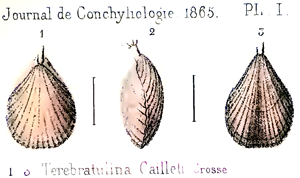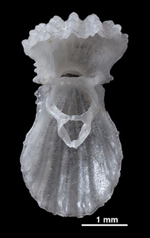|
Terebratulina kiiensis Dall et Pilsbry, 1891
Type locality: “Coasts of Province Kii, Japan, Strearns;”
Depth range: 18 - 1370 m (? 4640 m).
Terebratulina crossei : Helmcke (1939)
Terebratulina magalhaenica Helmcke, 1939
Terebratulina? crossei : Fischer & Œhlert (1882)
Terbratulina crossii Davidson, 1882
Terebratulina Dall, 1908
Terebratulina crossei ?: Foster (1969)
Diagnose in preparation -
Note: Helmcke (1939b, p. 240) mentioned that the diagnoses of the new species would follow later in a revision of the genus. Foster (1989, p. 284) stated that “the differences among the species of Terebratulina are in great need of further study on a worldwide level.” As Lüter & Sieben (2005) emphasized, this revision was never done until today.
|
|
|
Terebratulina retusa Linné, 1758
Type locality: « Habitat en pelago Norvegico » (Linné, 1767)
Depth range: 9 - 3614 m
Terebratulina caputserpentis Linné, 1767, not Linné (1758)
Anomia caputserpentis Linné, 1767
Anomia pubescens Linné, 1767
Terebratula retusa (Linné) : Retzius (1788)
Criopoderma caputserpentis (Linné) : Poli (1795)
Terebratula aurita Fleming, 1822
Terebratula costata Lowe, 1825
Terebratula emarginata Risso, 1826
Terebratula quadrata Risso, 1826
Delthyris spatula Menke, 1830
Terebratula caput-serpentis (Linné) : Sowerby (1847)
Terebratulina caputserpentis (Linné) : d'Orbigny (1847)
Terebratula striata Leach, 1852
Terebratulina retusa (Linné) : Dall (1920)
Diagnose in preparation -
|
|
|
Terebratulina austroamericana Zezina, 1981
Type locality: at 700 m, "Akademik Kutschatov" expedition 1968
Depth range: 18 - 2000 m
Terebratulina crossei Davidson: Fischer & Œhlert (1892)
?Terebratulina sp. Foster, 1974
Diagnose from description of Araya & Bitner (2018) modified -
Shell with lateral commissure nearly straight, forming an angle around 120° with the anterior edge of the beak; anterior commissure rectimarginate. Beak short, rounded, suberect, foramen slightly attrite, large, circular, permesothyrid with minute, rudimentary disjunct deltidial plates. Pedicle wide and short, distally divided into rootlets.
Shell surface of both valves covered with numerous ribs of rounded-triangular section with intercalated intermediate ribs up to fourth order. Some additional ribs bifurcate towards anterior edge; about 100 fine ribs present at edge of ventral valve, giving border a minute crenulation. Uneven, fine commarginal growth lines cross radial ribs.
Ventral valve with a sub-circular (or sub-elliptical) convexity in lateral view, but with a clearly regular parabolic outline in posterior or anterior views; valve interior with small hook-like teeth, pedicle collar short. Muscle scars not evident in examined specimen. Crura long and thin. Loop broken, with only wide, flattened dorso-ventrally descending branches.
Dorsal valve slightly convex in lateral view.
|
 Figure d'après Araya & Bitner (2018) |
|
Terebratulina cailleti Crosse, 1865
Type locality: Guadeloupe (Antilles, France).
Depth range: 32 - 1163 m
Diagnose - original (Crosse,1865)
T. trigono-piriformis, convexiuscula, subpellucida, albido-cinerea, radiatim lirato-costulata, costulis distantibus, obsolete subgranosis, aliis e margine ad foramen euntibus, aliis interpositis et mox evanidis; utraque valva, subinflata, antice flexuosa, dorsalis in medio depressa, costulis fere omnino carens; foramen oblongo-rotundatum, sat magnum; rostrum attenuato-productum, oblique truncatum. — Long, valvæ dorsalis (e foramine ad marginem) 10, long, valvæ ventralis 8 1 /2, lat. utriusque valvæ 7 mill.
|
 From Pl. I of Crosse (1865)
 Specimen of Terebratulina cailleti Crosse from W. Marie Galante, revealing internal details, d'après Gaspard (2018).
|




